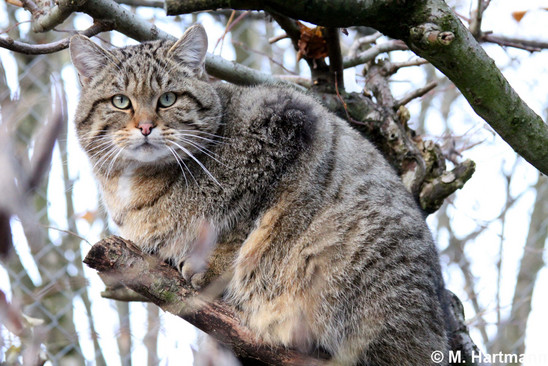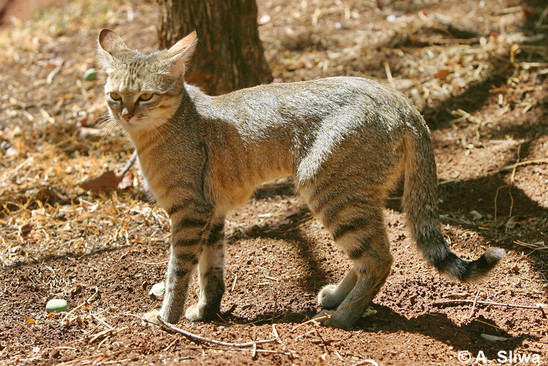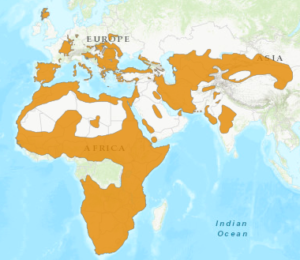The Wildcat ranges over Africa, Europe and central Asia to India, China and Mongolia. It is the most common and widely distributed wild cat species in the world. Their size, coat colour and pattern vary from continent to continent. Cats in drier areas tend to be pale or tawny with faint markings while those from humid areas tend to be darker and more heavily spotted or banded.
Scientific classification (taxonomy) of the Wildcat is constantly changing. In 2017, the revised taxonomy of the Felidae family recognized the following two full Wildcat species:
European Wildcat Felis silvestris – forest cats of Europe

Considered to have two subspecies:
Felis silvestris silvestris – Europe including Scotland, Sicily and Crete
Felis silvestris caucasica – Turkey, Caucasus (the border of Europe and Asia, includes Armenia, Azerbaijan, Georgia, Iran, Russia)
See also
Scottish Wildcat Felis silvestris grampia
African Wildcat Felis lybica – steppe and bush cats of Africa and Asia

Considered to have three subspecies (2017):
Felis lybica lybica – Eastern, western and north Africa, Arabian Peninsula, Middle East, Corsica, Sardinia, Crete
Felis lybica cafra – Southern Africa
Felis lybica ornata – Southwest and Central Asia, Afghanistan, Pakistan, India, Mongolia, China
See also
Gordon’s Wildcat Felis lybica gordoni
The Domestic Cat is classified as either Felis catus or Felis silvestris catus, depending on the author.

All domestic cats are descendants of a group of Wildcats from 9,000 – 10,000 years ago in the Fertile Crescent of Western Asia. This area is believed to be the origin of agriculture, when nomadic tribes first began to settle and grow crops. The grain was stored in granaries that attracted rodents, which in turn attracted Wildcats. With no further need to forage widely for food, the cats and humans began an alliance that is still in place today.
The most urgent conservation need is to identify genetically pure Wildcats and to prohibit hybridisation. However, this task is difficult as Wildcats cannot be distinguished easily from domestic cats or hybrids. Further research on hybridisation levels may warrant a reassessment of the Wildcat as a threatened species due to population declines of genetically pure Wildcats.
It is also important to agree on a clear taxonomy of the Wildcat: current legislation to protect the Wildcat can be only effective if they are seen as a separate species from the domestic cat. There is still a lack of information regarding the current status of both Wildcat species and population trends in many parts of their distribution ranges.
Overall, the Wildcat is classed by the IUCN Red Data List as Least Concern, although the Population Trend is Decreasing. Individual subspecies or regional populations are not classified on their own.
Previous Wildcat Classifications
2007 Classifications
- European Wildcat Felis silvestris silvestris – Europe
- African Wildcat Felis silvestris lybica – North Africa and southwest Asia
- South African Wildcat Felis silvestris cafra – Sub-Saharan Africa
- Asiatic Wildcat Felis silvestris ornata – Central Asia to India
- Chinese Mountain Cat Felis silvestris bieti – Western China
2005 Classifications
- Felis silvestris silvestris – Mainland Europe from Spain to Eastern Europe
- Felis silvestris caucasica – Turkey, Caucasus area
- Felis silvestris grampia – Northern Scotland
- Felis lybica lybica – deserts of North Africa
- Felis lybica ocreata – Ethiopia
- Felis lybica haussa – Nigeria
- Felis lybica foxi – Northern Nigeria
- Felis lybica rubida – Democratic Republic of Congo
- Felis lybica ugandae – Sudan, DRC, Uganda, Kenya
- Felis lybica tristrami – Israel, Jordan, Syria, Lebanon
- Felis lybica iraki – Kuwait and Iraq
- Felis lybica gordoni – Oman, United Arab Emirates
- Felis lybica nesterovi – Iraq and southern Iran
- Felis lybica reyi – Corsica
- Felis lybica cretensis – Crete
- Felis lybica jordansi – Balearic Islands (Mediterranean)
- Felis lybica cafra – Southern Africa
- Felis lybica griselda – Angola, Namibia, Botswana
- Felis lybica ornata – West and central India
- Felis lybica caudata – Turkestan, Iran, Afghanistan
- Felis lybica chutuchta – Gobi Desert, China
Prior Felis silvestris classifications
- F s silvestris – Europe
- F s caucasica – Caucasus Mountains and Turkey
- F s grampia – Northern Scotland
- F s caudata – deserts east of Caspian Sea to China
- F s gordoni – Coast of Oman
- F s iraki – Arabian desert regions
- F s nesterovi – Mesopotamia
- F s tristrami – Palestine and Red Sea Coast of Arabia
- F s cretensis – island of Crete
- F s haussa – northern Spain
- F s jordansi – Jordan
- F s reyi – Corsica
- F s rubida – one specimen from the Congo
- F s ornata – India west through Iran
- F s lybica – desert regions of North Africa to Sudan and Niger
- F s cafra – Zimbabwe, Mozambique and South Africa
- F s foxi – Senegal to Lake Chad
- F s griselda – Kalahari to south Angola
- F s brockmani – Somalia
- F s mellandi – south central Africa
- F s ocreata – Ethiopian highlands
- F s pyrrhus – northern Angola and southwest Zaire
- F s sarda – Morocco and Algeria
- F s ugandae – eastern Africa
4 Responses